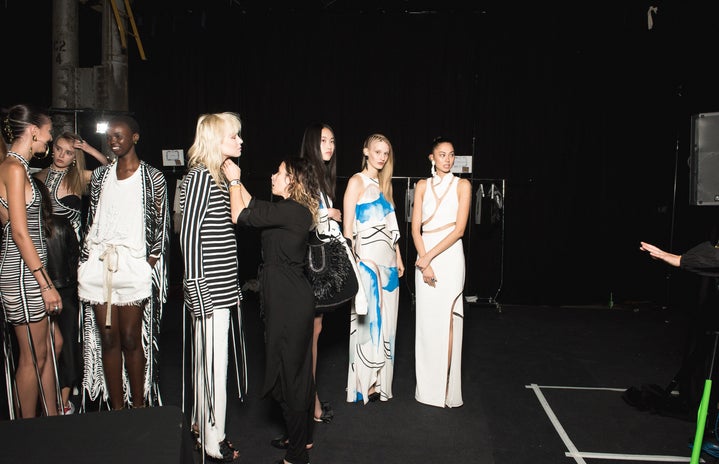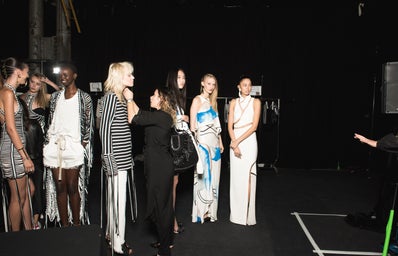Manfred Thierry Mugler, one of the world’s most esteemed fashion designers, passed away on January 23rd, at age 73, leaving a big impact on the industry. In fact, the creator was so much more than just his brand – he was a complete artist, who also explored dance, theater and photography, while he changed clothing’s shapes and exhibitions.
Early Life
Born in 1948, in Strasburg, France, Manfred Thierry Mugler began to study classical dance at the age of 9. He then worked as a professional dancer for six years, and by age 14, he joined the ballet corps for the Rhin Opera. Besides enjoying being on stage, those were sad and lonely times, as he never had someone waiting for him backstage. However, Manfred later redirected this loneliness and the passion for performances into his fashion creations, showing the world something unique and bold.
In terms of education, as a teenager, he studied interior design at the Strasbourg School of Decorative Arts. At some point in his early twenties, Mugler moved to Paris and started working for different boutiques as a freelance designer – and that’s where his career began.
The 1970s – The Beginning as a Designer
In 1973, at age 25, Mugler launched his first personal clothing collection, titled “Café de Paris“. At this very first reunion of pieces, it is already possible to see one of the designer’s trademarks: the work with wide shoulders, creating an image of a woman that is sophisticated, urban and contemporary.
Three years later, fashion editor Melka Tréanton asked Mugler to show his work in window displays for cosmetic brand Shiseido. He accepted the opportunity, which brought him more recognition.
Mugler opened his first boutique in 1978, and his collection was very well received, again with many pieces with broad shoulders and a confection that played with diverse shapes and cuts. He was part of a new avant-garde wave in France, and made clothes based on triangles and spirals, which shot himself to international fame. At the time, the New York Magazine referred to it as “1930s Flash Gordon Fascist Chic alongside Claude Montana and French Andre C”.
The 1980s – “Manfred’s Decade”
When the 1980s arrived, Mugler was already a fashion superstar, joined by names such as Alaia, Claude Montana and Jean-Paul Gaultier. In Vogue’s “History of 20th Century Fashion”, journalist Jane Mulvagh says “Mugler married couture traditions with cult dressing”. This was highlighted on the runway, where he made it seem like a spectacle.
“I have the feeling that I have already been doing couture, with all the research I put into the cut. My couture won’t be about embroidery! But it will be equally for Madame Mitterrand or Michael Jackson”
Mugler, about his first couture collection.
This was also the decade where he launched a photography book, “Thierry Mugler – Photographer“. In terms of business, he was keen to shoot some of his own advertising campaigns, many times in exotic locations. He also directed video clips and short films. Some of his clothes were often made for movies, operas and concerts.
In 1986, eight years after the opening, Manfred bought out the initial investors of his company and obtained full ownership and control.
The fashion shows
Going in the same direction as Mugler’s personality and creativity, he made his fashion shows true spectacles, always over the top and different from what anyone had seen before. Some were shown in arenas, and thousands could watch it live. Others brought the theater element and had models dressed (and performing) as cowboys, vampires, aliens, robots – according to the theme of the collection.
This way of portraying a runway show changed the industry and if nowadays we are used to seeing complex settings of lights, scenarios and personalities, that is due to Mugler’s work. Subtly, the casting of his shows also rallied against ageism and fatphobia, focusing more on the charisma and personality of the models.
In reality, Mugler’s shows were not only about the clothes, distancing itself from mere commercial purposes, they always had a concept. And that has its root on the artist’s background. When you dance, you embrace a moment, a personality. That can also happen in fashion, since it is a way to express and know yourself.
His Muses
During his entire career, Mugler’s designs were seen on some of the most famous celebrities. The pieces were used by David Bowie, Liza Minnelli, Demi Moore (with a special highlight for her costume on the movie Indecent Proposal), Celine Dion and George Michael, as well as supermodels Cindy Crawford and Naomi Campbell, for example.
In the 21st century, the artist dressed Beyoncé for her “I Am” World Tour, Cardi B and Kim Kardashian – her iconic 2019 Met Gala look, which gives the impression of a wet dress, was designed by Mugler.
Fragrances
One of Mugler’s passions were the fragrances he created, which also left the world delighted. In 1992, his first perfume, Angel, was launched – one of the best selling in the world. The bottles, in shape of a star, harken back to Manfred’s days as a dancer and personal life.
About the story of the perfume, journalist Suzy Menkez wrote for Vogue:
“I remember so clearly a conversation with Thierry Mugler in the Nineties, when he told me that his first fragrance, Angel, with its faceted bottle of an
exploding star, came directly from his personal turmoil as a young gay man, too guilty to go to the cathedral in Strasbourg, and instead lying on a bench outside, looking up at the stars that would become a symbol of his lifelong work”
The fragrances became financially important to the company, since they sold well and had high profit, and are extremely famous to this day. In 1997, Clarins, the cosmetics brand, obtained the rights to Mugler’s name. Thierry Mugler left fashion, officially in 2002, saying it wasn’t fulfilling him anymore.
Mugler’s Influence On Current Fashion
Although his official retirement from fashion was in 2002, Manfred Thierry Mugler left an eternal mark in the history of fashion. After leaving the industry, he made some exceptions and worked with global celebrities.
In 2018, Casey Cadwallader became the creative director of House of Mugler. He reworked geometric suits, and did works with corsetry, sheer, paneling, and bodycon dresses, putting the brand under the spotlight again.
Elements of Thierry Mugler’s fashion are strong on current fashion – different cuts, showing glimpses of skin; corsets; well structured clothes; broad shoulders; bold looks and shows. Indeed, Manfred was a design genius, an artist with multiple skills, and worked lines and shapes as a “fashion architect”. His creativity is an enormous legacy to the industry.
———————————————————————————————————————-
The article above was edited by Marina Ponchio.
Liked this type of content? Check Her Campus Casper Libero home page for more!


